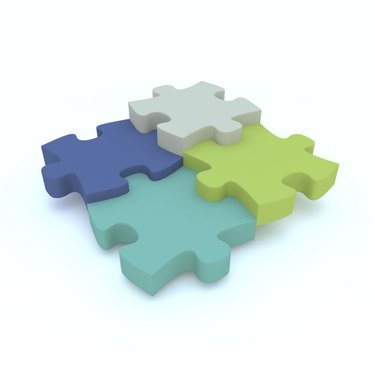
Create an animated jigsaw puzzle in PowerPoint in which each piece of the puzzle flies, bounces or otherwise moves onto the slide to display the image or text you want to present. The trick is to add the content to the slide as a background, hide that background and then format clip art puzzle pieces to display the original background. The result is an eye-catching animation that will leave your audience bedazzled by your extraordinary presentation skills.
Step 1
Add a blank slide to the presentation where you want the jigsaw puzzle to appear. Click the "New Slide" drop-down in the Slides group of the Home tab and choose "Blank Slide."
Video of the Day
Step 2
Right-click the slide and select "Format Background." Select "Picture or Texture Fill." Click the "File" button under Insert From, select the image you want to appear and click "Insert." Click "Close" to close the Format Background dialog.
Step 3
Add a white square to cover the background image. Select the "Insert" tab, click "Shapes" and choose the square. Drag the square onto the slide, covering the entire slide. Click the "Format" tab under Drawing Tools. Click "Shape Fill" and choose "White" and then click "Shape Outline" and choose "White."
Step 4
Select the "Insert" tab. Click "Online Pictures." Type "puzzle" into the Office.com Clip Art box and press "Enter." Choose the "Four Interlocking Puzzle Pieces" image, which is a vector file that can be separated. Alternatively, use another set of puzzle-piece images of your choice. Drag the image to fit the entire slide as closely as possible.
Step 5
Right-click the image, point to "Group" and select "Ungroup." Click "Yes" if a prompt appears asking whether you want to convert the image to a Microsoft Office drawing object, so you can animate each puzzle piece independently. Right-click the first shape, choose "Format Shape" and choose "Slide Background Fill." Click "Close." Repeat with the remaining shapes.
Step 6
Press the "Ctrl" key and click on each puzzle piece in the order you want it to appear on the slide. Select the "Animations" tab and choose the animation you want to use. Click "Animation Pane" in the Advanced Animation group. Click the drop-down arrow next to the first, piece, choose "Effect Options" and apply the options you want to use, such as "After Previous." Repeat for each piece.
Step 7
Click the white background square. Choose "Disappear" in the Exit Animations section. Click the drop-down arrow next to "Rectangle" in the Animation Pane and choose "After Previous." The white background will disappear to display the entire image after the puzzle is complete.
Video of the Day